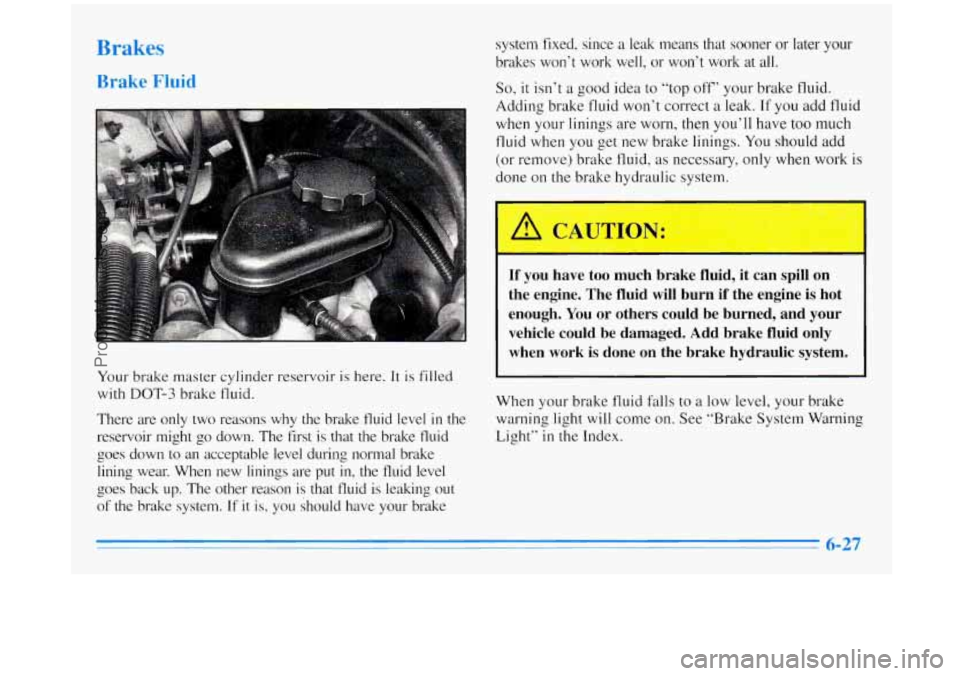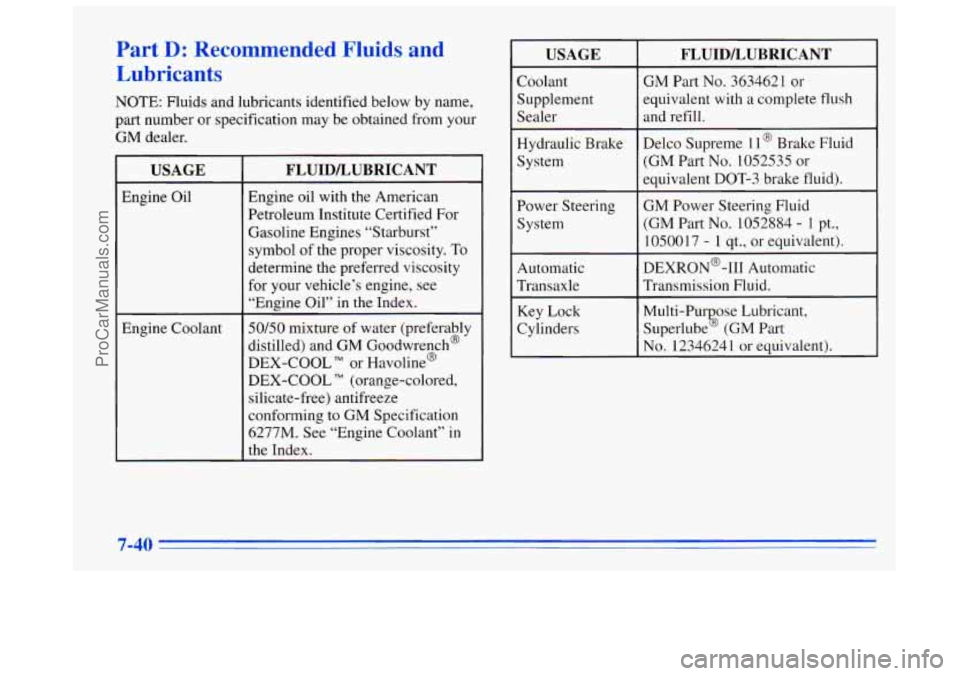Page 187 of 356

Parking on Hills
You really should not park your vehicle, with a trailer
attached, on a hill.
If something goes wrong, your rig
could start to move. People can be injured, and both
your vehicle and the trailer can be damaged.
But if you ever have to park your rig
on a hill, here’s
how
to do it:
1. Apply your regular brakes, but don’t shift into
PARK (P)
yet.
2. Have someone place chocks under the trailer wheels.
3. When the wheel chocks are in place, release the
regular brakes until
the chocks absorb the load.
4. Reapply the regular brakes. Then apply your parking
brake, and then shift
to PARK (P).
5. Release the regular brakes.
When You Are Ready to Leave After
Parking on a Hill
1. Apply your regular brakes and hold the pedal down
while you:
Start your engine;
Shift into a gear; and
0 Release the parking brake.
2. Let up on the brake pedal.
3. Drive slowly until the trailer is clear of the chocks.
4. Stop and have someone pick up and store the chocks.
Maintenance When Trailer Towing
Your vehicle will need service more often when you’re
pulling a trailer. See the Maintenance Schedule for more
on this. Things that are especially important in trailer
operation are automatic transaxle
fluid (don’t overfill),
engine oil, belt, cooling system and brake adjustment.
Each of these is covered in this manual, and the Index will
help you find them quickly. If you’re trailering, it’s a good
idea to review these sections before you start your trip.
Check periodically to see that all hitch nuts and bolts
are tight.
4-35
ProCarManuals.com
Page 229 of 356
Hood Release
.. . /! CAUTION:
Things that burn can get on hot engine parts and
start a fire. These include liquids like gasoline,
oil, coolant, brake fluid, windshield washer and
other fluids, and plastic
or rubber. You or others
could be burned. Be careful not to drop or spill
things that will burn onto
a hot engine.
To open the hood, first
pull
the handle inside
the vehicle.
Then
go to the front of the vehicle and release the
secondary hood release. Lift the hood.
6-7
ProCarManuals.com
Page 230 of 356
When you open the hood on the 3.1L L82 engine, you'll see:
D
A. Engine Coolant E. Engine Oil Dipstick I. Windshield Washer
Recovery Tank F. Automatic Transaxle Dipstick
Fluid Reservoir
B. Radiator Fill
Cap G. Brake Fluid Reservoir J. Battery (located under
C. Power Steering Reservoir
H. Air Filter Windshield Washer
D. Engine Oil Fill
Cap Fluid Reservoir)
ProCarManuals.com
Page 231 of 356
When you open the hood of the 3.8L L36 engine, you’ll see:
r
A. Engine Coolant
Recovery Tank
B. Radiator Fill Cap
C. Power Steering Reservoir
D. Engine Oil Dipstick
It‘ A
E. Engine Oil Fill Cap
F. Automatic Transaxle Dipstick
G. Brake Fluid Reservoir
H. Air Filter
I. Windshield Washer
Fluid Reservoir
J. Battery (located under
Windshield Washer Fluid
Reservoir)
6-9
ProCarManuals.com
Page 241 of 356
Checking the Fluid Level
1. Park your vehicle on a level place. Keep the
2. With the parking brake applied, place the shift lever
engine running.
in
PARK (P).
3. With
your foot on the brake pedal, move the shift
lever through each gear range, pausing for about
three seconds in each range. Then, position the shift
lever in
PARK (P).
4. Let the engine run at idle for three to five minutes,
Then, without shutting off the engine, follow these steps:
The transaxle dipstick
handle is the red loop
near the back of
the engine.
1. Pull out the dipstick and wipe it with a clean rag or
paper towel.
2. Push it back in all the way, wait three seconds and
then pull it back out again.
3. Check both sides of the
dipstick, and read the
lower level: The fluid
level must be in the'
cross-hatched area.
4. If the fluid level is in the acceptable range, push the
dipstick back in all the way.
6-19
ProCarManuals.com
Page 249 of 356

Brakes
Bri lid
Your brake master cylinder reservoir is here. It is filled
with
DOT-3 brake fluid.
There are only two reasons why the brake fluid level
in the
reservoir might go down. The first is that the brake fluid
goes down to an acceptable level during normal brake lining wear. When new linings are put in, the fluid level
goes back up. The other reason is that fluid is leaking out
of the brake system. If it is, you should have your brake system fixed, since
a leak means that sooner or later your
brakes won’t work well, or won’t work at all.
So, it isn’t a good idea to “top off’ your brake fluid.
Adding brake fluid won’t correct
a leak. If you add fluid
when your linings are worn, then you’ll have too much
fluid when you get new brake linings.
You should add
(or remove) brake fluid,
as necessary, only when work is
done on the brake hydraulic system.
If you have too much brake fluid, it can spill on
the engine. The fluid
will burn if the engine is hot
enough. You or others could be burned, and your
vehicle could be damaged. Add brake fluid only
when work is done
on the brake hydraulic system
When your brake fluid falls to a low level, your brake
warning light will come on. See “Brake System Warning
Light”
in the Index.
6-27
ProCarManuals.com
Page 250 of 356
What to Add
When you do need brake fluid, use only
DOT-3 brake
fluid
-- such as Delco Supreme 11 @ (GM Part
No. 1052535). Use new brake fluid from a sealed
container only, and always clean the brake fluid
reservoir cap before removing it.
-
With the wrong kind of fluid in your brake
system, your brakes may not work well, or they
may not even work at all. This could cause a
crash. Always use the proper brake fluid.
NOTICE:
0 Using the wrong fluid can badly damage
brake system parts. For example, just
a few
drops
of mineral-based oil, such as engine
oil, in your brake system can damage brake
system parts
so badly that they'll have to be
replaced. Don't let someone put in the
wrong kind
of fluid.
0 If you spill brake fluid on your vehicle's
painted surfaces, the paint finish can be damaged. Be careful not to spill brake fluid
on your vehicle. If you do, wash it
off
immediately. See "Appearance Care" in
the Index.
6-28
ProCarManuals.com
Page 326 of 356

Part D: Recommended Fluids and
Lubricants
NOTE: Fluids and lubricants identified below by name,
part number or specification may be obtained from your
GM dealer.
USAGE
Engine Oil
Engine Coolant
FLUIDLUBRICANT
Engine oil with the American
Petroleum Institute Certified For Gasoline Engines “Starburst”
symbol of the proper viscosity. To
determine the preferred viscosity
for your vehicle’s engine, see
“Engine Oil” in the Index.
50/50 mixture of water (preferably
distilled) and
GM Goodwrench@
DEX-COOL
TM or Havoline@
DEX-COOL (orange-colored,
silicate-free) antifreeze
conforming
to GM Specification
6277M. See “Engine Coolant” in
the Index.
USAGE
Coolant
Supplement
Sealer
Hydraulic Brake
System
Power Steering
System
Automatic
Transaxle
Key Lock
Cylinders
FLUIDLUBRICANT
GM Part No. 3634621 or
equivalent with a complete flush
and refill.
Delco Supreme 11
@ Brake Fluid
(GM Part No. 1052535 or
equivalent
DOT-3 brake fluid).
GM Power Steering Fluid (GM Part
No. 1052884 - 1 pt.,
1050017 - 1 qt., or equivalent).
DEXRON@-111 Automatic
Transmission Fluid.
Multi-Pur ose Lubricant,
Superlube
b (GM Part
, No. 1234624 1 or equivalent).
ProCarManuals.com